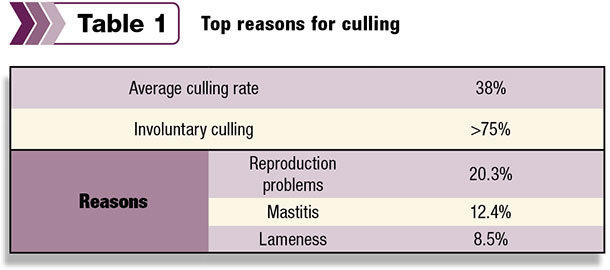The strong selection for milk production has led to an increased incidence of metabolic diseases around the calving period, which leads to impaired reproduction. This translates into a very high culling rate in most herds, as reproduction is the largest reason for involuntary culling (Table 1).
 Average reproductive performance of dairy herds is very low (Table 2) and very costly for producers. Each extra day open may represent a loss of $4 per day, and a 1 percent decrease of pregnancy rate will represent $17 when pregnancy rate is low.
Average reproductive performance of dairy herds is very low (Table 2) and very costly for producers. Each extra day open may represent a loss of $4 per day, and a 1 percent decrease of pregnancy rate will represent $17 when pregnancy rate is low.
 Although the overall management of cows is critical, this article will concentrate on nutrition and its essential role, as feed accounts for more than 50 percent of production costs.
Although the overall management of cows is critical, this article will concentrate on nutrition and its essential role, as feed accounts for more than 50 percent of production costs.
The essential role of micronutrients
For decades, we have concentrated on macro-nutrition, energy, protein and macro-minerals.
We never anticipated that trace elements such as selenium, copper, zinc, manganese, fat-soluble vitamins like A, D and E, and water-soluble vitamins such as choline, folic acid, riboflavin and others could have such an impact on the overall metabolism of carbohydrates, fats and protein.
It has since been discovered that B vitamins specifically have an impact on immune function during transition and are involved in the expression of certain genes necessary for the regulation of metabolic processes and reproduction (nutrigenomics).
Recent research on B vitamins
Important pieces of research have created new perspective for nutrition during the transition and lactation periods. It has been proven that B vitamins are very much degraded in the rumen, which justifies their protection when added in feed.
Choline, folic acid and B12 play a very significant role in the reduction of liver fat infiltration, caused by tissue mobilization during the transition period. Folic acid and B12 improve energy balance by reducing the cow’s mobilization of fat tissues and reducing days to first breeding.
Oxidative stress has a negative impact on the immune system and reproductive ability of the cow. Riboflavin has an important enzyme co-factor role, which helps reduce oxidative stress.
Protected B vitamins, including folic acid, riboflavin and choline, fed during the transition period improved dry matter intake before calving and reduced BHB levels in blood, leading to fewer metabolic disorders and improved reproduction.
A blend of protected B vitamins containing folic acid, biotin, pantothenic acid, pyridoxine and vitamin B12 improved first service per conception by 13 percent and reduced culling rate.
Nutrigenomics and B vitamins
Nutrigenomics is a new tool to optimize health, reproduction and productive performance of dairy cows.
It is now recognized that animals perform differently with specific diets and that nutrients have the ability to interact with the animal’s genome. Nutrients are now considered as well as “signaling molecules” and can control gene expression.
With this new approach, it is possible to evaluate the effect of specific nutrients like B vitamins at the cellular or organ level. This enables a better understanding of the mode of action of specific nutrients on the metabolism of the animal.
In fact, recent research using nutrigenomics has shown that folic acid and vitamin B12 affected the expression of specific genes and could regulate both follicular development and ovulation processes in dairy cows.
The dominant follicle was larger, and results implied that the follicle was preparing earlier for ovulation.
Producers face real challenges when dealing with metabolic diseases around calving and their resulting problems, like decreased reproduction and reduced longevity, to name a few. B vitamins are now known to play a critical role in some essential functions, including reproduction.
The better understanding of their specific mode of action, and the opportunity to supplement in the diet under a rumen-protected form, creates new nutritional solutions to solve problematic situations that are often assumed and accepted as normal. PD
References omitted due to space but are available upon request. Click here to email an editor.

-
Hélène Leclerc
- Technical Support and R&D – Ruminant Nutrition
- Jefo
- Email Hélène Leclerc









